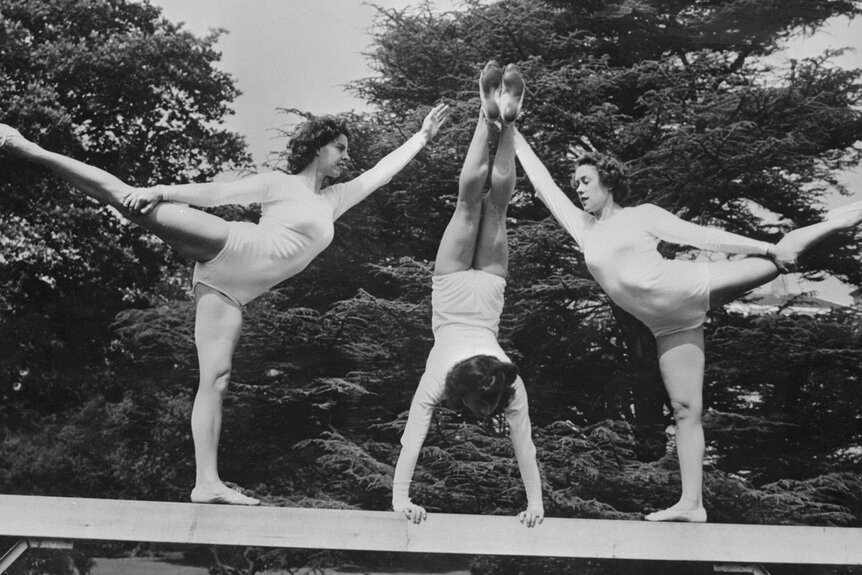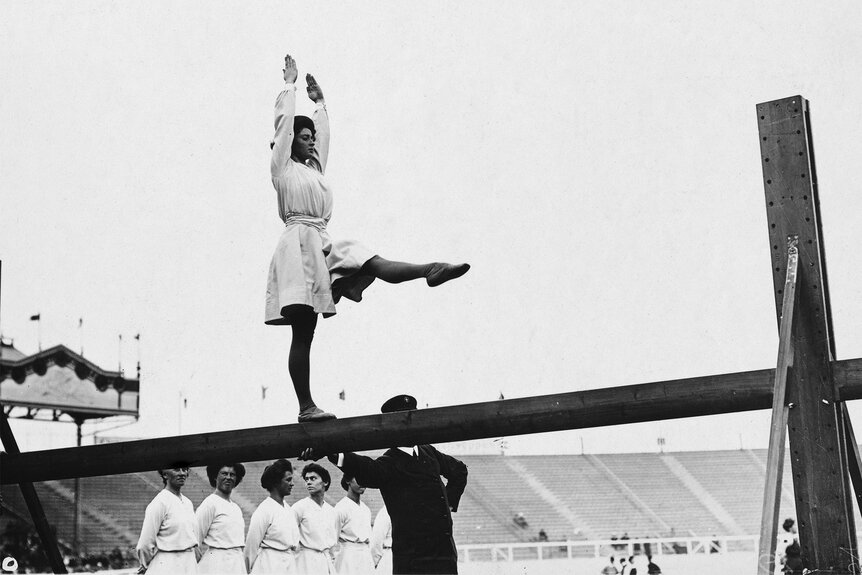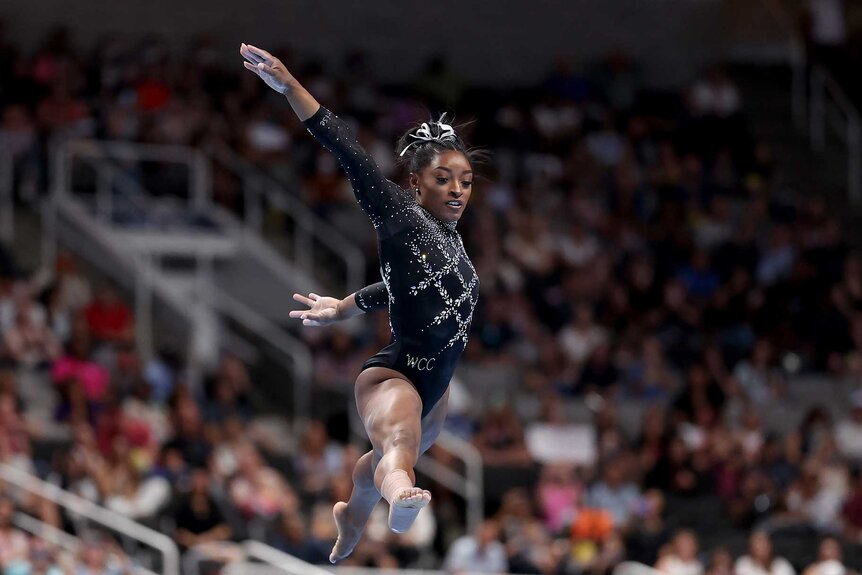A Her-story of Women’s Gymnastics in the Olympic Games
With female sports once considered by male Olympic leaders as "uninteresting" and "improper," women's gymnastics reigns as one of the Games' most-watched sporting events.
Women have made great strides (handsprings, flips, and splits, too) in rhythmic and artistic gymnastics, trailblazing the way for the American athletes now headed to the 2024 Summer Olympic Games in Paris.
Long before legends such as Simone Biles became a household name as one of the most decorated female gymnasts in Olympic history, women’s gymnastics was a loosely organized sport with little oversight in the late 1800s. But, with structure and growing popularity, it evolved into what it is today, a must-watch sporting event in the Olympic Games.
Learn about women's gymnastics' rich history and how it impacts the Games today.
RELATED: Simone Biles Has the Best Response to Olympic Critics
Women only began competing in 1928
Women were only allowed to compete in Olympic artistic gymnastics beginning with the 1928 Games in Amsterdam, according to Olympics.com, the same year many mainstream sports — including modern Athletics — were opened to females. Before then, the men’s-only gymnastics events (which then included rope-climbing but did not include an official floor routine) steadily grew as a staple event since appearing in the first modern Games in 1896.
The inclusion came against contemporaneous views that women shouldn’t be in competitive sport, even with the establishment of the F.I.G. (Fédération Internationale de Gymnastique) in 1881.
At the turn of the century, French I.O.C. (International Olympic Committee) cofounder Pierre de Coubertin — regarded as the father of the Modern Games — said in 1912 that it was “impractical, uninteresting, ungainly and, I do not hesitate to add, improper” to allow women in the Olympics, according to The New York Times. He remained “strongly against it” in 1928, as well.
It was thanks to women like the founder of the International Women’s Sports Federation, Alice Milliat — infamously viewed (or dismissed) on the fringes of the Olympic movement at the time — that women’s sports were permitted in the Amsterdam Games. According to The New York Times, the board allowed five of Milliat’s requested 10 female sports’ events, but only on the condition that she not use the word “Olympics.”
In 1928, 60 female gymnasts competed in five 12-person groups (one for each participating country: France, Italy, Great Britain, Hungary, and Holland) and only as a team, as opposed to individually, according to The Gymternet. The events included drills, apparatuses, and jumps, and the official rules at the time were vague, at best.
The women's U.S. team began competing in 1936, first placing in 1948 with the bronze medal.
Gymnastics grew in popularity following World War II and after the Soviet Union entered the Olympic scene at the Helsinki Games in 1952, according to the sport’s governing body, the F.I.G. In the 1980s and 1990s, with the likes of Mary Lou Retton and Shannon Miller, the U.S.A. rose as one of the globe’s top contenders in the sport, which today includes team and individual events in vault, beam, uneven bars, and floor exercises.
Rhythmic Gymnastics
Rhythmic gymnastics, which incorporates music and dance to perform exercises with the hoop, ball, clubs, and ribbon, came years later. According to NBC Olympics, the sport made a name for itself in World Championships between 1963 and 1973, but it didn’t make its Olympic debut until the 1984 Games in Los Angeles, as detailed by Olympics.com.
Before then, the F.I.G. didn’t recognize the women’s-only sport until 1961. However, it did appear in the1952 Helsinki Games and the 1956 Melbourne Games, but as part of the artistic gymnastics events.
RELATED: Team USA's Gymnastics Leotards Are Shimmering with Thousands of Crystals
According to NBC Olympics, the debut only featured four individual competitors, though a group event was introduced in the 1996 Atlanta Games. Not unlike artistic gymnastics, former Soviet states and Eastern Europe have dominated the competition, with Russia keeping 10 of 17 titles since it became an Olympic sport
Evita Griskenas currently leads the U.S.A. into the 2024 Games as the only American competing in rhythmic gymnastics. In a July 6, 2024, interview with Team U.S.A., one filled with fun sticker games and prompts, she discussed recent obstacles (such as breaking her foot), her faith in God, and the desire to keep rhythmic gymnastics alive and thriving.
“I want to leave a legacy in the rhythmic gymnastics world,” said Griskenas. “It’s slowly becoming more popular, and more people know what it is, and I just want to be able to share my love, my resiliency, passion, beliefs, commitments, and overcoming the odds with everyone who is part of my journey.”
Who is the oldest female gymnast to have competed in the Olympics?
Now 49 years old, eight-time Olympian Oksana Chusovitina of Uzbekistan became the oldest female gymnast to compete in the Olympics when, at 46, she competed in the 2020 Games in Tokyo.
The gold and silver medalist hoped to compete in the 2024 Games in Paris, but during the Asian Championships in May 2024 — her last chance to qualify — she sustained an injury during a floor training exercise, which prevented her from making her ninth Olympic appearance, as reported by NBC Olympics.
“I will not be able to take part, and I am very upset as I have been preparing for this competition for a long time,” she lamented in a May 23, 2024, video on Instagram. “I started doing all-around, and I wanted to perform in our country, in front of our fans. But unfortunately, you will not see me among the participants.”
Chusovitina previously announced plans to retire following the Tokyo Games but decided to give it another shot in Paris.
For Team U.S.A., the late Marie Margaret Hoesley remains the oldest American female Olympian gymnast 72 years after competing in the 1952 Helsinki Games at age 35, according to Portland’s NBC affiliate KGW. This year, four-time gold medalist Simone Biles, at 27, will be the oldest American to compete since, according to NBC News.






































